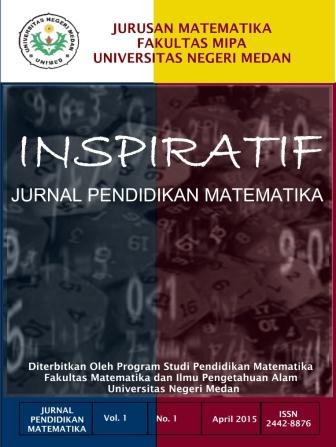PENERAPAN MODEL KOOPERATIF TIPE NUMBERED HEAD TOGETHER UNTUK MENINGKATKAN HASIL BELAJAR MATEMATIKA SISWA PADA SISTEM PERSAMAAN LINEAR DUA PEUBAH DI MTS RAUDHATUL HASANAH MEDAN
DOI:
https://doi.org/10.24114/jpmi.v1i1.8918Abstract
AbstractThe purpose of this study was to determine the increase in student learning outcomes on the subject of the system of linear equationswith two variables cooperative learning Numbered Head Together. Subjects in this study were class VIII-2 MTs Raudhatul Hasanah many as 31 people. The object of this research is the application of the cooperative model Numbered Head Together. The research instrument used by observation and tests. This type of research is a classroom action research. Before giving action, first given a diagnostic test to determine the ability and determination of the initial group of students based on ability level. The data provided in the form of shaped achievment test descipsion given twice at the end of each cycle. In this study the use of worksheets intended as teachingn tool to facilitate teaching and learning in cooperative groups. From the analysis of the data after a given action I (cycle I) obtained 23 out of 31 student (74,19%) reached mastery learning and 8 out of 31 students (25,80%) has not reached mastery learning with an average grade 68,70. In this cycle of learning completeness in classical yet achieved. From the analysis of the data after a given action II (cycle II) obtained 27 out of 31 students (87,10%) reached mastery learning, and 4 out 31 students (12,90%) has not reached mastery learning with an average grade 77, 09. In this cycle of learning completeness classically been reached. This means that an increase in student learning outcomes from cyle I to cycle II. Thus the implementation of cooperative learning model Numbered Head Together can improve student learning outcomes on the subject of the system of linear equations in two variables of class VIII MTs Raudhatul Hasanah.Keywords : Cooperative, Numbered Head Together, Raudhatul HasanahReferences
Abdurrahman, M., (2009 ), Pendidikan Bagi Anak Berkesulitan Belajar, Penerbit Rineka Cipta, Jakarta
Arikunto, S.,dkk., (2009), Penelitian Tindakan Kelas, Penerbit Bumi Aksara, Jakarta
Djamarah,S.,(1994) Prestasi Belajar dan Kompetensi Guru, Usaha Nasional, Surabaya
Fakultas Matematika dan Ilmu Pengetahuan Alam Universitas Negeri Medan, (2010), Buku Pedoman Penulisan Skripsi dan Proposal Penelitian Kependidikan, FMIPA Unimed
Hudojo, H, (1988), Mengajar Belajar Matematika, Depdikbud, Dirjen Dikti, P2LPTK, Jakarta.
Masykur, dkk, (2008), Mathematical Intelligence : Cara Cerdas Melatih Otak dan Menanggulangi Kesulitan Belajar, Penerbit Ar-Ruzz Media, Jogjakarta
Muhli,A,(2011),(https://wicaksono.blogspot.com/2011/08/02/efektivitas-pembelajaran/), (diakses 10 November 2014)
Muhammad, (2005), Pelatihan Terintegrasi Matematika Buku 3, Depdiknas, Jakarta
Nurhadi, (2004), Kurikulum 2004, Penerbit Grasindo, Jakarta.
Purwanto, (2011),Evaluasi Hasil Belajar, Penerbit Pustaka Pelajar, Yogyakarta.
Slameto, (2003),Belajar dan Faktor “ Faktor Yang Mempengaruhinya, Penerbit Rineka Cipta, Jakarta
Sudjana, (1992), Metoda Statistika, PenerbitTarsito, Bandung
Lundgren,(2009) http://herdy07.wordpress.com/2009/04/22/modelpembelajarannht numbered- head-together/)
Sudjana. N., (2009), Penilaian Hasil Proses Belajar Mengajar, Rosdakarya,Bandung
Trianto, (2009), Mendesain Model Pembelajaran Inovatif Progresif: Konsep Landasan, Dan Implementasinya Pada Kurikulum Tingkat Satuan Pendidikan (KTSP), Penerbit Kencana Prenada Media Group, Jakarta
Usman, U. (2004), Menjadi Guru Profesional, Penerbit PT Remaja Rosdakarya, Bandung

